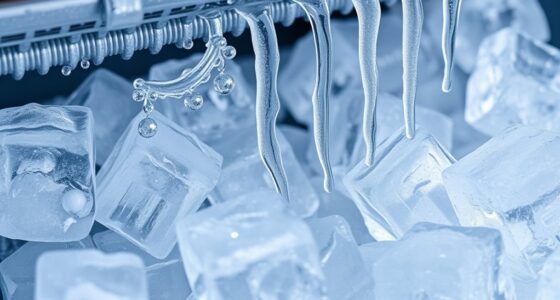The typical American household consumes roughly 13% of its energy on cooking. Selecting the appropriate kitchen appliances can significantly improve efficiency. By choosing the right appliances, you can save energy and simplify the cooking process. Therefore, when deciding between a toaster oven and a microwave, it’s important to consider their differences and determine which one best suits your needs.
Key Takeaways:
- Understanding the differences between toaster ovens and microwaves can help you make an informed decision.
- Toaster ovens offer versatility with their ability to toast, bake, broil, and roast, while microwaves excel in speed and convenience for reheating and defrosting.
- The choice between a toaster oven and a microwave depends on your specific cooking needs, kitchen space, and personal preferences.
- Consider factors such as cooking methods, crispy textures, and long-term utility costs when deciding between these two appliances.
- Both toaster ovens and microwaves can be valuable additions to your kitchen arsenal, depending on your lifestyle and culinary requirements.
Definition of Toaster Oven and Microwave
A toaster oven is like a mini version of a big oven. It’s great for toasting bread. But, it can also bake, broil, and roast. It’s small but does a lot, fitting right on your counter.
A microwave cooks food super fast with microwaves. These waves make the water in food heat up quickly. This means you can reheat or defrost in no time. It’s why microwaves are so popular.
So, a toaster oven can cook in many ways, making it super handy. A microwave, though, heats food fast and easy. Both are great in the kitchen.
Characteristics of Toaster Oven and Microwave
A toaster oven is great for many cooking tasks. It can make toast, bake, broil, and sometimes cook with a rotisserie. You can adjust its temperature to control your cooking perfectly. It is small, which is perfect for tiny kitchens or small spaces. The best things about a toaster oven? It’s versatile, has adjustable temperatures, and doesn’t take up much room. Toaster oven characteristics include versatility, adjustable temperature settings, and a small footprint.
Microwaves are all about speed and making things easy. They’re great at warming up food fast and thawing frozen stuff. Some can even grill. They have buttons that start heating right away, which is great if you’re busy. Microwaves also make sure your food heats up evenly. They stand out because they’re fast and simple to use. Microwave characteristics include quick-start buttons, efficient heating, and even heat distribution.
“Toaster ovens are versatile and compact, offering adjustable temperature settings for precise cooking control. Microwaves, on the other hand, prioritize speed and convenience, with quick-start buttons and efficient heat distribution.” – Kitchen Appliance Expert
Toaster Oven vs. Microwave Characteristics
| Toaster Oven | Microwave | |
|---|---|---|
| Main Features | Versatility, adjustable temperature settings, small size | Speed, convenience, quick-start buttons |
| Cooking Capabilities | Toasting, baking, broiling, sometimes rotisserie | Reheating, defrosting, some models have grilling capabilities |
| Size | Compact | Varies, but typically larger than a toaster oven |
| Ease of Use | Straightforward controls | Quick-start buttons for instant heating |
| Heat Distribution | Varies depending on model, with some offering even heat distribution | Even heat distribution for uniform cooking |
| Suitable For | Various cooking tasks, small kitchens | Quick and convenient meals, busy individuals |

Thinking about what you need in the kitchen? It’s smart to look at both toaster ovens and microwaves. The table above compares them well, showing what makes each special. Choosing between them depends on how you like to cook, your space, and your lifestyle.
Common Uses of Toaster Oven and Microwave
Toaster ovens and microwaves make cooking easy. They are used for different things in the kitchen. Knowing what they do can help you pick the right one.
Toaster Oven:
A toaster oven does many cooking tasks. Here’s what you can use it for:
- Toasting Bread: It makes bread crispy and golden. It’s great for breakfast toast or sandwiches.
- Reheating Pizza: It makes leftover pizza crispy again. It keeps the crust from getting soggy, unlike a microwave.
- Roasting Veggies: It roasts vegetables, making them flavorful and crispy on the outside, tender inside.
- Baking Small Batches of Cookies: It’s good for baking a few cookies without heating up a large oven. You get to eat warm cookies quickly.
Toaster ovens are very useful. They let you cook in many ways. This makes them a good choice for your kitchen.
Microwave:
Microwaves cook food quickly. Here’s what they are used for:
- Reheating Leftovers: They heat food fast and evenly. This means less time cooking and more time enjoying your meal.
- Defrosting Frozen Items: They thaw frozen food fast, making meal prep easier.
- Steaming Vegetables: Microwaves steam veggies quickly. Just add a little water and microwave until soft.
Microwaves are great for fast cooking. They are perfect for busy people who need to make meals quickly.
| Toaster Oven | Microwave |
|---|---|
| Versatile cooking methods | Quick reheating and defrosting |
| Crisp and brown food | Convenience and speed |
| Roasting veggies and small baking tasks | Efficient reheating of leftovers |
Note: The table above shows the main features and uses of toaster ovens and microwaves.
Now you know more about toaster ovens and microwaves. This can help you decide which one you need. Both have their pros, depending on what you like to cook.
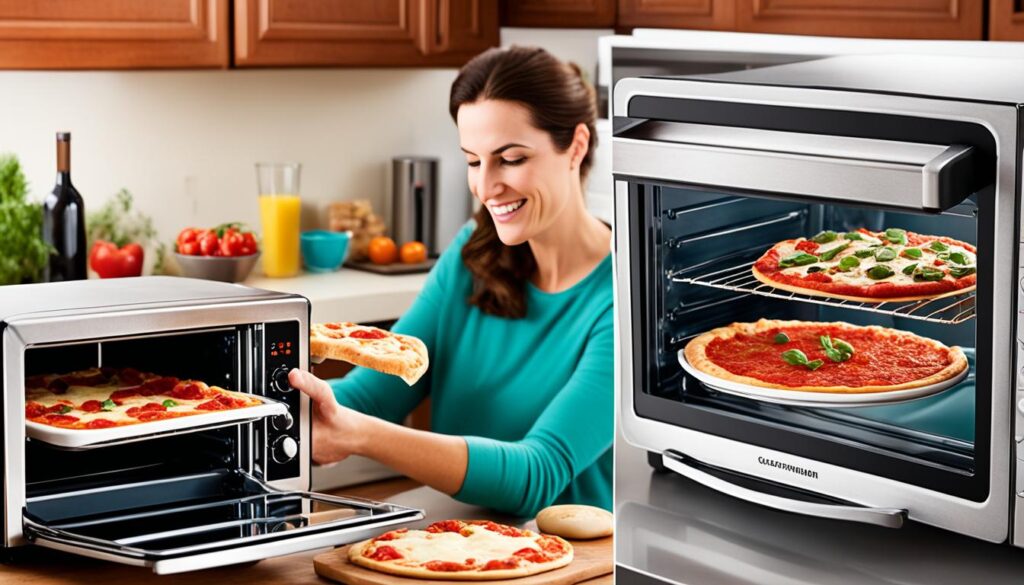
Unique Features of Toaster Oven and Microwave
A toaster oven has adjustable temperature settings. This means you can control the heat very precisely. You can bake, broil, or roast just right. Toaster ovens can also toast and brown food perfectly. This is great for crispy bread or melting cheese on casseroles.
Microwaves are known for their quick-start buttons and varying heat distribution options. The buttons make cooking simple and fast. You can heat drinks or leftovers with one touch. Microwaves cook and reheat food evenly. This prevents the need to watch and stir them.
“Toaster ovens delight home cooks with their adjustable temperature settings, enabling precise control for versatile cooking. Meanwhile, microwaves impress with quick-start buttons that offer shortcuts to everyday cooking tasks.”
Let’s look at a table comparing the unique features of toaster ovens and microwaves:
| Toaster Oven | Microwave |
|---|---|
| Adjustable temperature settings | Quick-start buttons |
| Ability to toast and brown food | Varying heat distribution options |
| Multifunctionality (baking, broiling, roasting) | Efficiency in reheating and defrosting |
Both toaster ovens and microwaves have features that meet different cooking needs. You might like precise control and versatility. Or you might prefer quick and easy cooking. It all depends on what you need in your kitchen.
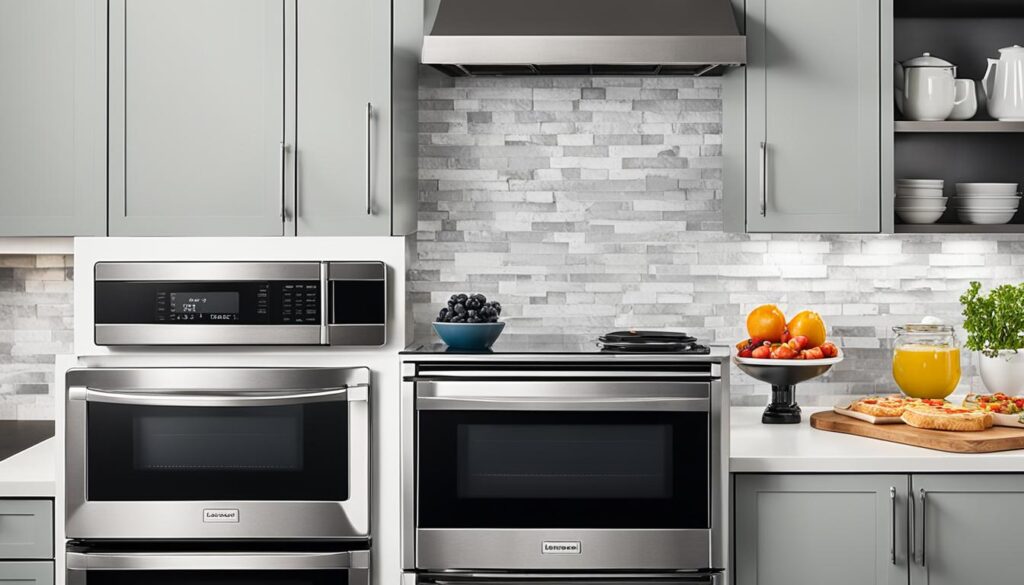
Cooking Capabilities of Toaster Oven and Microwave
Toaster ovens and microwaves are great for cooking. Each has special features. Let’s see what they offer:
Toaster Oven Cooking Capabilities
Toaster ovens have conventional heating. They allow accurate temperature control. This is ideal for different cooking styles. Here’s what toaster ovens can cook:
- Baking: From cookies and muffins to cakes and pies, toaster ovens can handle a wide range of baking tasks.
- Roasting: You can roast vegetables, chicken, and even small cuts of meat in a toaster oven, achieving delicious flavors and crispy textures.
- Broiling: Toaster ovens can broil steaks, fish, and other proteins, giving them a nice caramelized crust.
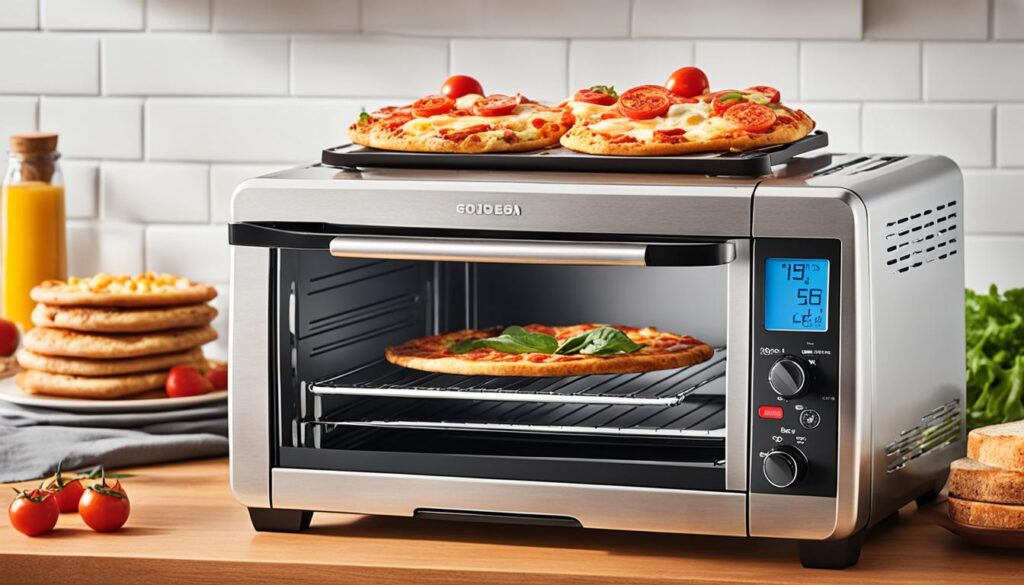
Microwave Cooking Capabilities
Microwaves use waves to heat quickly. They’re great at reheating and defrosting. But, they cook differently. Let’s see what microwaves can cook:
- Reheating: Microwaves are perfect for reheating leftovers, bringing them back to their piping hot state in a matter of minutes.
- Defrosting: Forgot to take the meat out of the freezer? No problem. Microwaves can quickly and evenly defrost frozen items, saving you time and hassle.
- Steaming: Microwaves with steaming functions make it easy to cook vegetables and fish, locking in nutrients and flavors.
Microwaves are quick and easy for meals. But, they might not make food crispy or crunchy like toaster ovens can.
We looked at what toaster ovens and microwaves can do. Let’s now find out about their speed and convenience.
Speed & Convenience of Toaster Oven and Microwave
Kitchen gadgets like toaster ovens and microwaves help us a lot every day. They make cooking quick and easy. Let’s look at how they do that.
Speed of Toaster Oven
A toaster oven cooks your food just right. It takes a bit longer than a microwave, but the food tastes great. If you’re making toast or heating up a small meal, it’s pretty fast.
Convenience of Toaster Oven
Toaster ovens are great because they can do many things. You can bake cookies or roast veggies easily. They are small but can cook in many different ways.
Speed of Microwave
If you need your meal ready fast, use a microwave. Just press a button, and your food is hot very quickly. Microwaves are great for warming up food or defrosting things fast.
Convenience of Microwave
Microwaves are super quick and easy to use. They’re perfect if you’re really busy. Press a button, and you get a hot meal without waiting.
Both toaster ovens and microwaves have good points. Which one you choose depends on what you like to cook and how much time you have. Think about what you usually make and how quickly you need it done. We’ll look at more about both to help you decide.

Energy Efficiency of Toaster Oven and Microwave
Let’s compare the energy use of toaster ovens and microwaves. We will see how these appliances use energy in cooking.
Toaster ovens use more energy than microwaves because they cook longer and hotter. Yet, they’re better than big ovens for small meals.
Microwaves save more energy. They’re great for fast jobs like warming up or defrosting. So, they are more green for energy use.
Think about size, how you cook, and how long you cook. These things change how much energy you use and your bills.
Comparison of Energy Efficiency
Let’s compare how much energy a toaster oven and a microwave use:
| Toaster Oven | Microwave | |
|---|---|---|
| Cooking Task | Baking a small batch of cookies | Reheating leftovers |
| Time | 20 minutes | 5 minutes |
| Temperature | 375°F | High heat setting |
| Energy Consumption | Higher | Lower |
Making cookies in a toaster oven takes longer and uses more energy. But warming food in a microwave uses less energy. This shows how each is best for different food tasks.
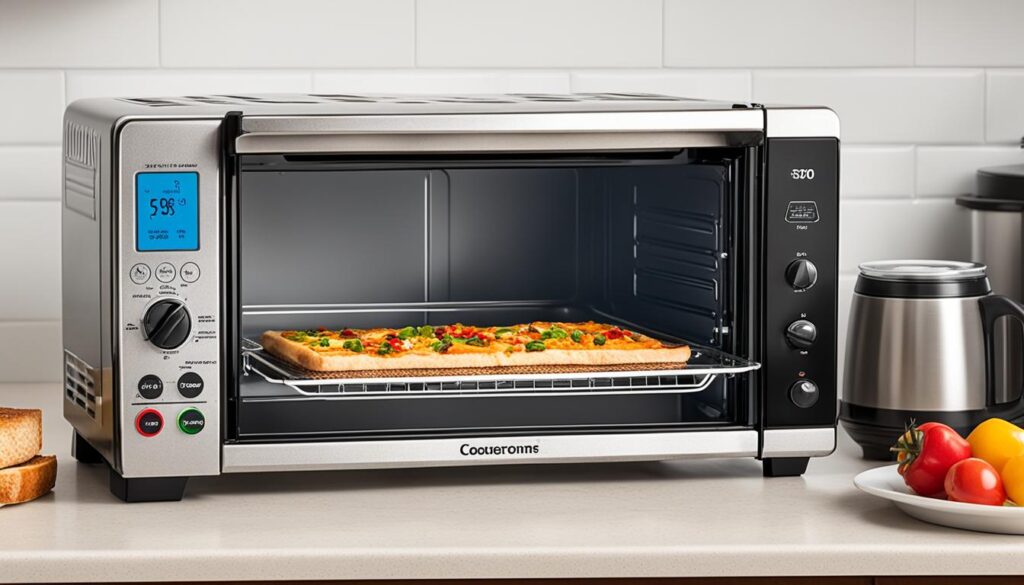
Thinking about energy use of toaster ovens and microwaves helps the planet and cuts costs. Choose based on what you cook. This way, you save energy and match your lifestyle.
Cost Implications of Toaster Oven and Microwave
When thinking about a toaster oven and a microwave, it’s key to look at all costs. This means both the first cost and the costs to keep it running.
Initial Costs
The first cost of a toaster oven changes based on the brand, model, and features. More advanced models are pricier than simple ones. But, think about a toaster oven as a long-term buy.
A toaster oven is flexible. It lets you bake, broil, and roast. This is great for people who like cooking different foods. Even if it costs more at first, the extra features improve your cooking.
Microwaves are usually cheaper to get, especially simple models. If you just warm up food or do simple cooking, a cheaper microwave works well.
Operating Costs
Operating costs are what you pay to use these devices, like the power they use. Toaster ovens might add more to your energy bill. This is because they cook longer and need more heat for some foods.
Cooking in a toaster oven takes warming up and more time. This means you use more energy. But, for small meals or when you need exact heat, a toaster oven might save energy compared to a big oven.
Microwaves save energy. They cook food fast with microwaves, cutting down on cooking time and energy costs. If you care about saving energy and keeping utility bills low, a microwave is smart.
| Costs | Toaster Oven | Microwave |
|---|---|---|
| Initial Cost | Varies based on brand, model, and features | More budget-friendly upfront |
| Operating Costs | May increase energy bill due to longer cooking times and higher temperatures | Generally more energy-efficient and cost-effective for monthly utility bills |

Looking at both first costs and running costs helps you choose wisely. Whether you like many cooking options or saving energy, know these costs to pick the right appliance for you.
Conclusion
After looking into toaster ovens and microwaves, we see they both have good points. Toaster ovens can toast and brown food well, offering many ways to cook. Microwaves, on the other hand, are fast and easy to use.
What should you pick? It depends on what you need. If you like crispy food and different cooking styles, go for a toaster oven. If you want your food heated quickly without hassle, choose a microwave.
In the end, what you choose is up to you. Both can be great for your kitchen, depending on what you like to cook, how much room you have, and your taste in food. Think about what matters most to you and make the choice that fits your life.





